Chris & Allyson vs. California (2014)
Day Six: Venice Beach. Arrival in Hollywood. "Jimmy Kimmel Live!" A paparazzi moment.
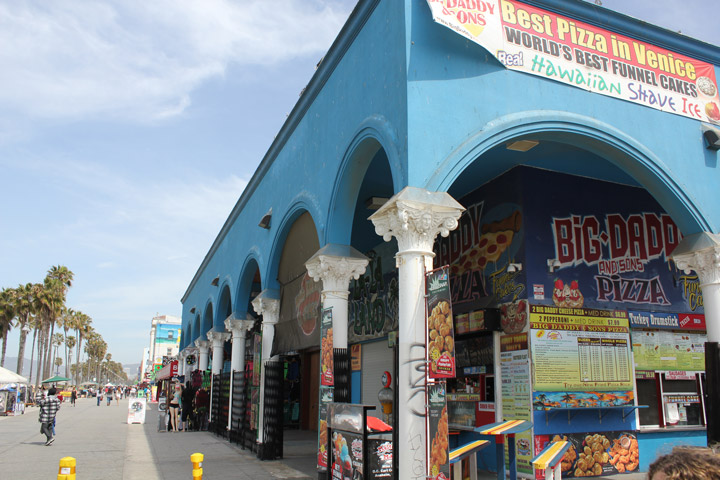
The iconic facades of Venice Beach -- once high-brow, now low-brow.
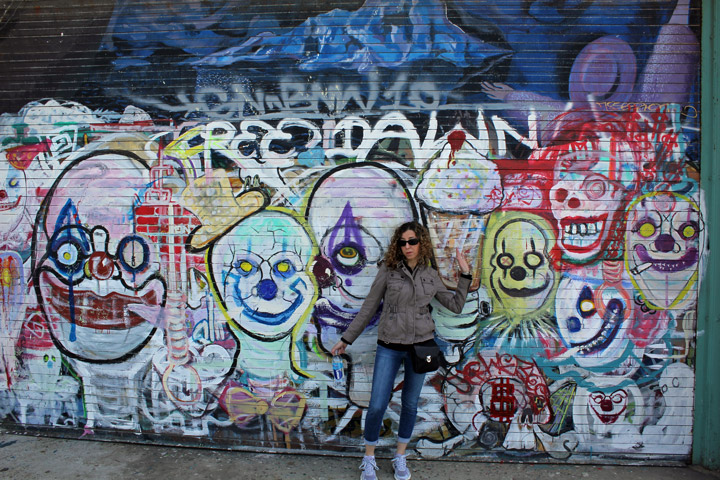
Beautiful street art abounds on the Venice Beach boardwalk.
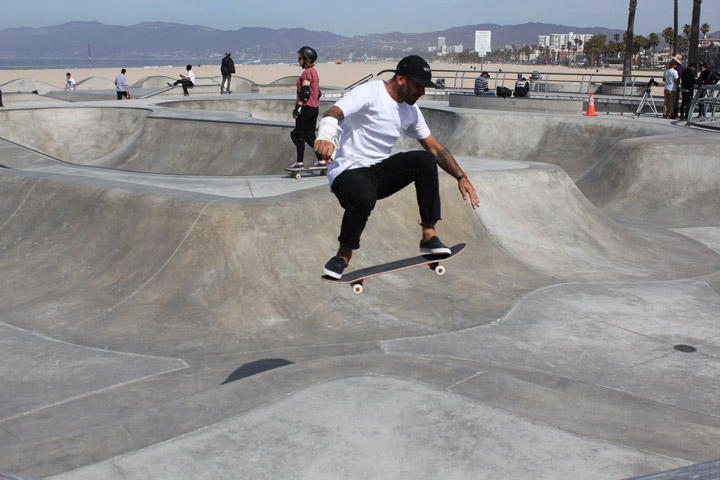
Probably one of the more scenic skate parks around. Venice Beach.
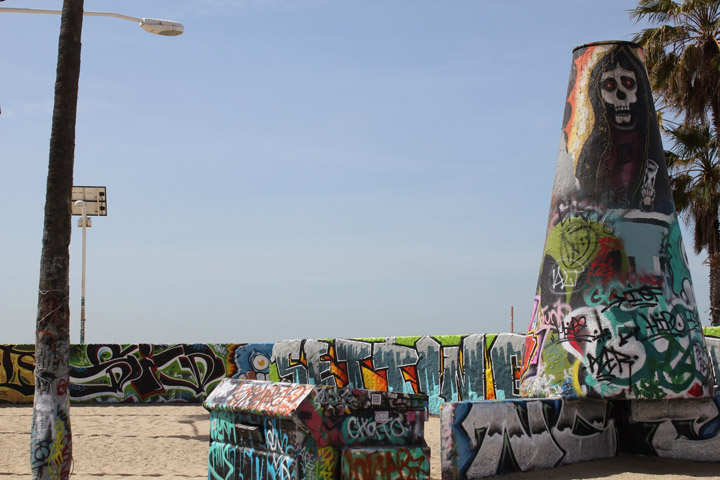
Tagged, you're it ...
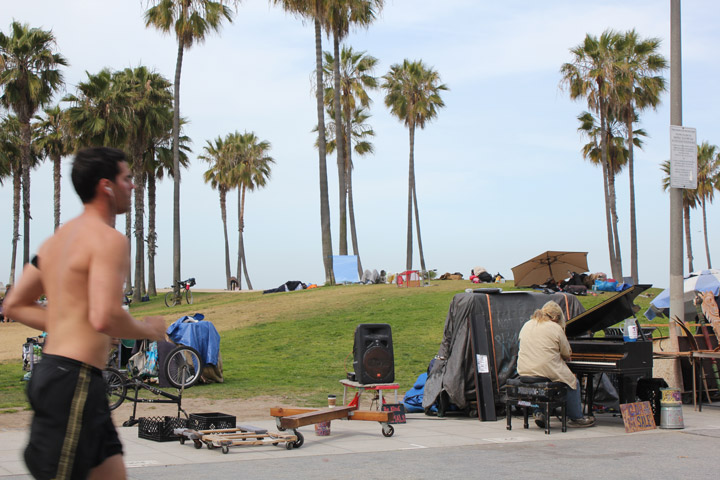
He hauls out an entire piano and plays for tips. That's dedication.

We squeezed in a few quick sets before heading to Hollywood.
It's a hateful thing to judge a man by his appearance. The value of a person is not determined by dress, or a manner of walking, or a pattern of speech. Those who gawk at strangers for rank amusement are among the most despicable specimens of humanity.
Unless they're on vacation, in which case they're just "people watching." One of the finest people-watching locations in America is Venice Beach -- as seen in "Fletch" -- and we started our first morning in Los Angeles a few miles away.
It was a nice morning. Not nice enough for buxom 24-year-old babes to be giving each other innocent rubdowns while wearing string bikinis, but nice. Allyson and I walked the paved path by the beach. It's a nice beach, but I grew up on the natural splendor of the Jersey Shore, so it's not THAT nice.
But the beach wasn't the point. After a mile, we reached the world-famous Venice Beach Boardwalk, which famously has no boards. It's a long strip of concrete between the beach and the storefronts, and there are "stalls" painted on the ground that hundreds of vendors or performers can rent out. We were walking through on a Wednesday morning, but there were still some all-stars on the promenade.
- Mexican skull people. There were at least fourteen stalls selling small decorated skulls. There is apparently a hugely unsatisfied market for Dia de los Muertos enthusiasts. If you have spare cash, sink it all in Mexican skull futures as soon as possible.
- Folk singers. Since the 1960s, it has been scientifically proven that the best way to affect societal change is to not shower, learn three guitar chords and sing preachy lyrics at people who are wandering past you in a non-concert setting. Venice Beach continues in this great tradition.
- The "Fishing for Nugs" guys. In an intriguing business model, several enterprising gentlemen set up comfortable seating on the Venice Beach boardwalk, profess their enthusiasm for cannabis and ask you to underwrite them. They appear to be renting a stall, so there must actually be people who give them money, so that they can buy pot. California!
- A fat guy with a small piano. A large gentleman somehow transports a baby-baby-grand piano to the boardwalk. He plays it and accepts tips. This guy is actually pretty good.
- Dirty hippies. They didn't rent a stall, but several youngish people chose to ask for money, then make fun of my pale complexion when I didn't give them any. California!
There's also action off the boardwalk. We stopped and watched the show at a skate park, and we sat on the bleachers at Muscle Beach, Venice Beach's (semi) outdoor public gym. In its heyday, it was the meathead mecca, where insanely buff guys would show off insane feats of strength to anyone passing by. Assisted by copious amounts of steroids, Schwarzenegger, Ferrigno and more would use that gym to show off. On a Wednesday morning in the 21st century, it looks a little worn around the edges, but it's still nice to say you went there.
As to why it's called "Venice Beach": back in the day, a promoter built an entertainment complex with buildings replicating the style of Venice, Italy. It was hotspot for silent movie stars, but strangely enough that wasn't enough to stay trendy for 100 years. The complex fell into disrepair for a few decades, until it was rescued by new businesses taking advantage of the cheap real estate prices. You can still see the Venice theme in a few colonnades; we stopped to have breakfast at a café and book store built on the ruins of the past. (In accordance with California law, I had a burrito.) The fat guy with the small piano was just across from us, so we enjoyed a smattering of pseudo-classical hits while continuing to people-watch. It was a fine morning, and we were glad to see one of L.A.'s finest human freak shows.
But why have hamburger when you can have steak? When we were done with Venice, we made our way back to the car. We found the freeway, drove through Beverly Hills and cruised the Sunset Strip. And within an hour, we were in Hollywood, the freak show that will ultimately undermine all of Western Civilization.
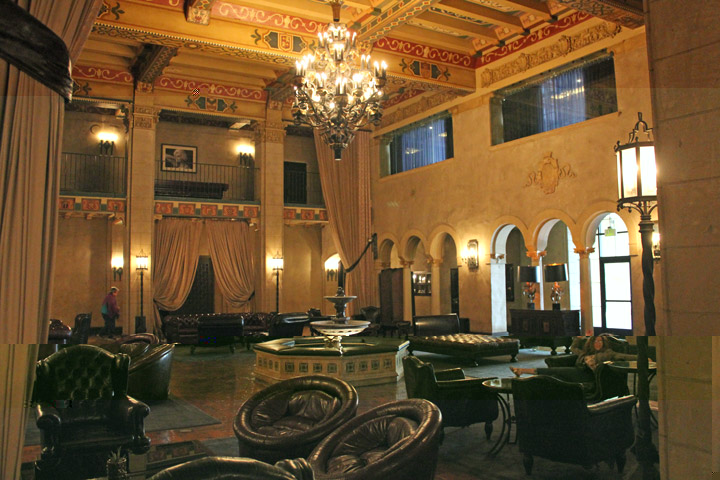
The lobby of the historic Hollywood Roosevelt, home to the first Oscars.
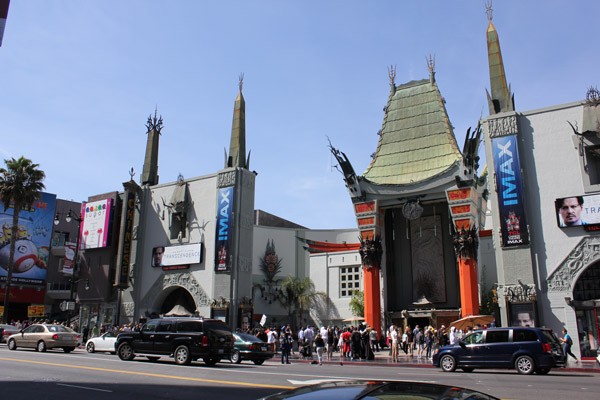
Grauman's Chinese Theater, the most iconic spot for movie premieres.
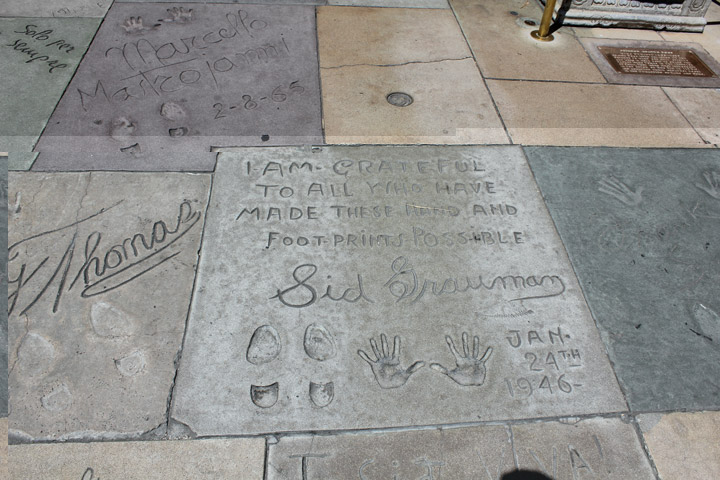
The hand and foot prints of the boss himself.

Hollywood's Masonic Temple, where "Jimmy Kimmel Live!" is taped.
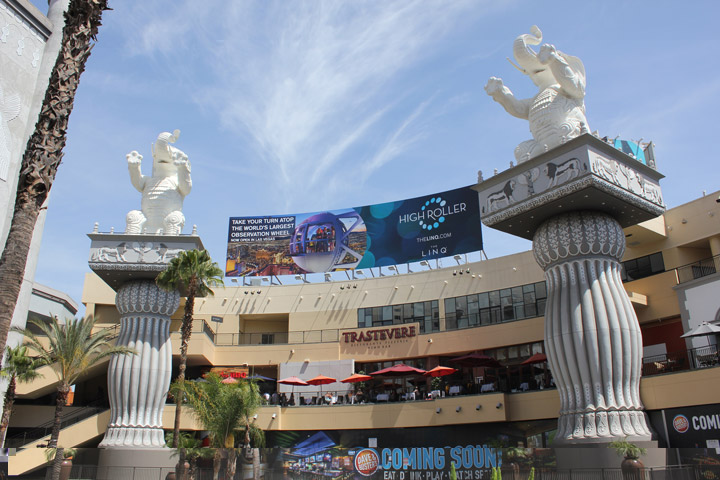
Hollywood and Highland, a shopping mall and perennial home of the modern-day Oscars.
The Hotel Roosevelt is right on the edge of that freak show. Built in 1927, it features a combination of touristy trash and old-Hollywood elegance. The first Oscars were held there in 1929, and it's two blocks from where the Oscars are held today. It has really elegant lounges and courtyards, as well as a stunning outside pool; these days, those areas are largely populated by Americans aspiring to be Eurotrash. The walls are a little thin and the drinks are a little expensive, but it's right in the belly of the beast. They also have valet parking. We loved it.
There's lots to see in Hollywood, beginning with the ground itself -- the Roosevelt is right on the Walk of Fame. If you have achieved something of note in the fields of music, television, movies, radio or theater, and you are willing to pay a sizable fee to the Hollywood Chamber of Commerce, and you agree to show up for the dedication ceremony, you can be immortalized with a pink star that millions of people will thoughtlessly walk on for generations. Some people will even stop to take a picture of your star, which bears your name but absolutely no information about your accomplishments; you will also have no control over which business your star eventually appears in front of. Maybe you were a world-famous silent-movie star whose pioneering work created opportunities for four generations of actors -- there's a good chance your star is currently floating between a wig shop and an erotica store. It is possible to have multiple stars, for achievements in multiple categories; the only person with five stars is Gene Autry, "the singing cowboy." Most of today's youth do not know who Gene Autry was, or what a cowboy actually is, or why a cowboy would be singing, or what it would sound like without autotune. Pop culture is awesome, and dreams really do come true in Hollywood.
The biggest concentration of stars is right around Grauman's Chinese Theater, which is just across the street from the Roosevelt and about the same age as the hotel. Sid Grauman was a showman, and he lived in an era where it seemed perfectly reasonable to decorate a movie theater like a giant Chinese pagoda. China was still exotic back then, and not the nation that will inevitably send a human wave of shock troops to overwhelm the Pacific Northwest. There's still something mildly exotic about the theater, thanks to the many foreign tourists, as well as the numerous people dressed in super hero costumes. The heroes will pose in your pictures for money. There's still apparently a big cultural demand for middle-aged Spider-Men, as well as Jack Sparrow impersonators.
The theater has hosted countless red carpet movie premieres over the years; most important, it's the setting of the climactic battle in "Blazing Saddles." The Walk of Fame is nice, but the greatest honor the entertainment industry can bestow is allowing an artist to leave their handprints and footprints in the concrete outside of Grauman's. The greatest honor any civilian can bestow on an artist is to stand in their footprints and wonder why such a high percentage of Hollywood stars have been tiny, tiny people.
If there's a theme here, it's that Hollywood lies. It's a town of tiny people and unglamorous settings, where most things are "fixed in post," by what people politely call "magic." There's another example of this right next to Grauman's. The Hollywood and Highland complex is a fine multi-story shopping complex. It also holds the theater where the Oscars take place each year.
Yes, the Oscars are held in a mall. They must set up giant screens to cover up the Hard Rock Café when stars are walking the red carpet. Also, I suspect that the red carpet is added digitally, and that stars are actually stepping over the prone bodies of middle-aged Spider-Men who have been incapacitated by security.
Allyson and I walked about a mile down Hollywood Boulevard. After you get past Hollywood and Highland, there are gift shops, and wig shops, and lingerie stories. There's a Scientology center, a Ripley's Believe it or Not, the remains of Grauman's Egyptian Theater, and a few gritty-looking night clubs. We would have walked further, to find the bus depot where doe-eyed Iowans with big dreams are met by honest talent representatives from all the major studios.
But we had an appointment. One of Allyson's Hollywood dreams was to see a television taping. She's a classy lady, so she specifically wanted to see "Dr. Phil." But in Hollywood, most dreams end with sorry compromise. Due to scheduling realities, we ended up with tickets for "Jimmy Kimmel Live."
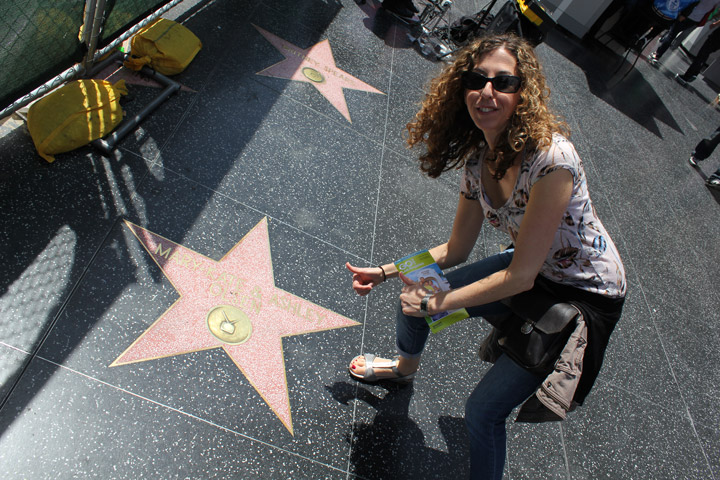
We found the BEST star, for Mary-Kate and Ashley.
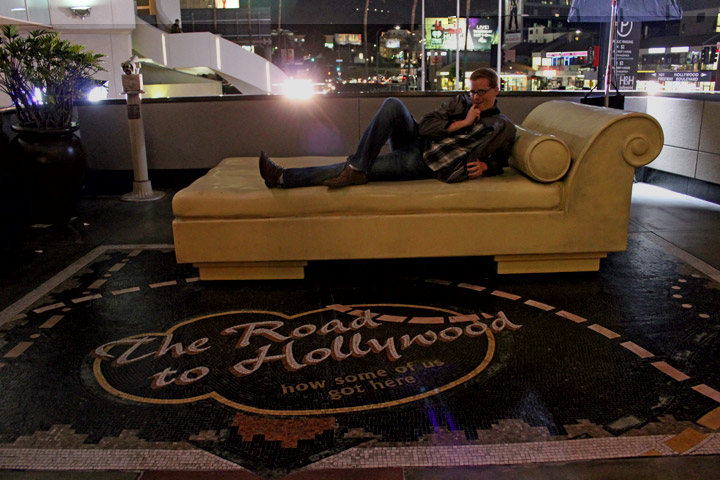
This photo was taken well before the Me Too movement.

Spying on a taping of "America's Got Talent." That's Nick Cannon in the yellow suit, greeting fans.
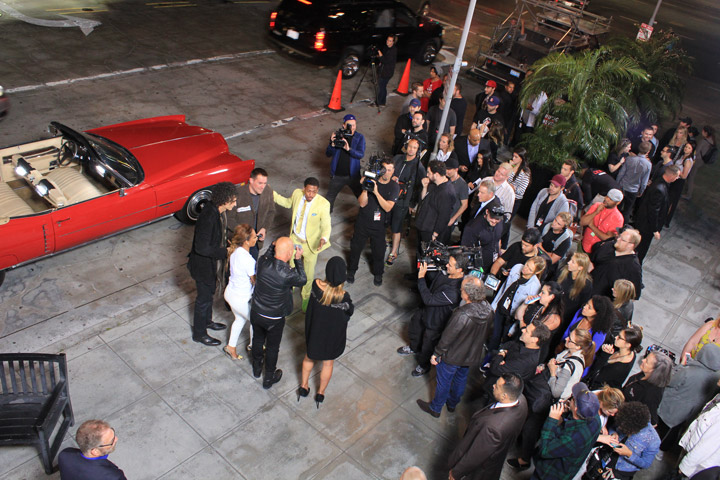
The AGT taping: Howard Stern, Heidi Klum, Howie Mandel, Howard Stern, Nick Cannon.
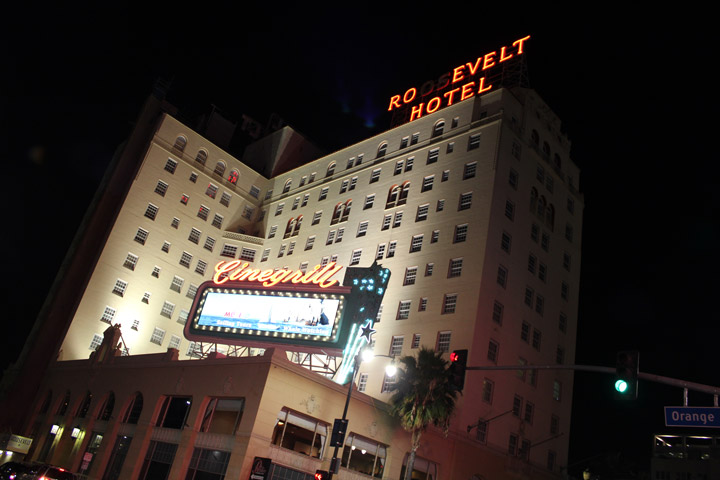
Home sweet home. The Hollywood Roosevelt at night.
Miraculously, that show tapes on Hollywood Boulevard, one block from the Roosevelt, in an old Masonic temple. It was our chance to see Hollywood magic up close:
When you get special VIP tickets for Kimmel, that entitles you to stand on the sidewalk for 60 to 90 minutes. This gives the production assistants a chance to log your entry, assemble a demographic profile and use a complex algorithm to make sure the minorities in the audience are equally distributed around the room for crowd shots. It also gives you a chance to interact with the street folks, whom you cannot run away from for fear of losing your seat. That's not such a bad thing. One guy has been working the Kimmel line for years; he's a larger black dude who dresses like the Mad Hatter, carries his own sound system and endlessly loops a beat. He asks you what your name is, then does an improvised rap. At this point, it's probably not improvised at all, since he's heard every name hundreds of times -- even the weird ones that people make up trying to stump him. Some people are very uncomfortable when he approaches, but if you're on vacation, your best bet is to let the guy rhyme "Chris" with "siss," give him $5 and take a picture.
Once Jimmy Kimmel has awoken from his hyperbaric oxygen chamber, they let you into the building and seat you. While awaiting further instructions, you get to watch past Kimmel clips to get you in the mood. Then, another production guy comes out and lectures you on how to be a studio audience: If you think something wasn't funny, laugh; if you experience a sudden aortic dissection, laugh; if you realize in the middle of the taping that all existence is meaningless and the entire universe will eventually implode into a space smaller than a golf ball, laugh; if you are told to laugh, laugh; If you actually think something was funny, laugh like your entire family will be drawn and quartered in front of you unless you laugh loud enough. Also, feel free to hoot or clap, but no whistling.
A "warm-up guy" comes out to engage the audience. Kimmel's warm-up guy of many years is named Don. He is a bald man, who is excellent at seeming excessively creepy; if I were a betting man, I would put everything I own on the fact that Don, at some point in his life, has traded pot for sexual favors. He didn't really tell jokes, but he did dance awkwardly while sticking his tongue out and engage in overtly lecherous chit-chat with several people in the audience. Of course, there's more than one way to skin a cat. Some warm-up guys get a crowd going with humor. Don apparently creates a tremendous sense of anxiety, so that when the host finally arrives, he is greeted enthusiastically as the man saving the crowd from Don. And then, in all likelihood, Don goes out and obtains pot for the writing staff.
The show itself runs like clockwork. Jimmy Kimmel seems mildly interested in the crowd, but he pushes his way through. They finish the "couch" segments in about the time it takes to watch them on television. Tim Allen came out to promote his ABC sitcom that no one apparently was watching. Ginnifer Goodwin, who was extremely pregnant, plugged "Once Upon a Time" and talked about her wedding. They did a quiz show segment where two people staying in a hostel answered questions about Los Angeles for the right to stay overnight in the Hotel Roosevelt. When it was time for the musical guest, Foster the People, they ushered us out to the back parking lot. A big stage -- and another crowd of yokels from the streets of Hollywood -- was waiting. We saw two songs taped for the show, then enjoyed a half-hour mini-concert afterward. In true modern fashion, half the crowd watched the entire performance by recording it on their iPhones.
Grousing aside, it's a fun time. It's interesting to see how many people it takes to produce 40 minutes of television a day. There are nonprofits fighting African famine that have smaller budgets than the team of production assistants that have to handle Tim Allen. Family members watching at home spotted us in the crowd shots, so if anyone ever asks, I appeared on "Jimmy Kimmel Live" in 2014. That appearance on PBS just got knocked down on the resume.
As we were leaving, it was about 7. Allyson and I are authentic people who believe in helping the local economy as much as possible. We wanted an authentic California dinner that spoke authentically to our belief in authenticity. So we went to the California Pizza Kitchen in Hollywood and Highland. Our choice to go local was rewarded. As we were leaving dinner, we noticed a crowd on the balcony outside the restaurant. They were gathered for the greatest of all Hollywood traditions: staring at celebrities like zoo animals.
We had stumbled on a taping of a segment for "America's Got Talent." The segment in question involved a very interesting talent. A man whose head was wrapped in black electrical tape drove the judges around the block in a convertible. This probably took about 60 seconds of actual airtime, but the shoot had to last an hour. About 80 percent of the motion picture business involves standing around waiting. Scientology is really just a way to pass the time.
In this case, production guys had to cordon off a sidewalk, a police escort had to get in position, and they needed shots of Heidi Klum, Howie Mandel, Howard Stern and one of the Spice Girls standing on the sidewalk. The hosts chatted amongst themselves, talking about whatever Howie Mandel and the Spice Girls might have in common. Eventually they got into the car and drove around the block. When the lap was complete, there was a definite cut to make the parking process seem smoother -- then everyone stood around on the sidewalk to talk about this guy's amazing talent. It will definitely come in handy once the government starts giving blind people preferential treatment in the awarding of commercial driver's licenses. Nick Cannon was also there, in a yellow suit. Naturally.
No matter how dignified you think you are, when confronted with famous people, your biological impulse is to take thousands of pictures, like the creep you really are. I probably took more pictures trying to get a good look at Heidi Klum's face than I took of Alcatraz. I could have taken even more, but it was tough to frame a shot so that it also avoided showing Howard Stern's face.
We wrapped up our night with a drink in the lobby bar at the Roosevelt, where the only thing more padded than the drink prices are the leather chairs. There were younger and hipper people all around us -- people whose nights were just starting. To them, we probably looked old, sad and underdressed, with no sense of style. Anyone who overheard us talking about Nick Cannon or Tim Allen probably thought we were unspeakably lame. But they were probably on vacation, so it qualified as people watching. Live and let live.
